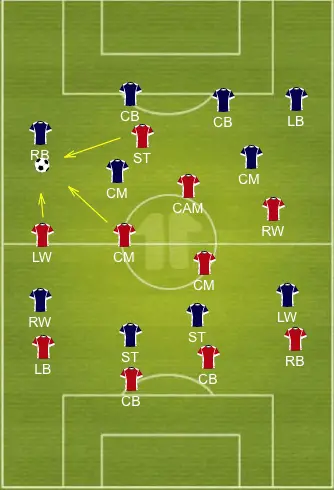Introduction:
The idea of pressing is to put pressure on the ball with the intention of winning it back off of the opposition. By forcing the opposition to complete an action in a pressured atmosphere, every aspect of that action is made more difficult. An action consists of both a decision and the execution of that decision – if these two aspects can be manipulated correctly, the opponent will lose the ball. Successful examples of this high energy style of play can be seen in the Borussia Dortmund side of 2013 who narrowly lost in the UEFA Champions League final that year.
Advantages:
The system can be tailored to expose particular weaknesses identified in the opposition. For example, if it is recognised that the passing ability of the players playing in the oppositions defence is limited then you would organise your team to press from the front.
The idea of pressing also forces the opposition to play their normal passing game under pressure, meaning the ball can be turned over through positional play and running off of the ball. This can help take the onus of the defence to do the ‘defending’ as it done by the whole team at large in this system.
It is also important to mention the idea of counter-pressing whereby if a team is pressured and loses the ball when attacking it will seek to win it back instantly as opposed to settling into a defensive shape. For example, it is widely acclaimed that when the Barcelona side under the tutorship of Pep Guardiola lost the ball, they are were given 6 or 7 seconds seconds to win it back. If they did not do it in this time they would then settle into shape. By doing this they are able to win the ball back high up the pitch and disrupt the opposition’s transition from defence to attack. Speaking about this style of play, Barcelona full-back Dani Alves said, “Pressing is difficult to pull off, but when the team manages it well, there is no better way to win games. You must see where the ball is likely to go, then react immediately to press the opponent or intercept any pass. When we lose the ball, we want to win it back immediately, which is when this tactic is so good and works so effectively.”
Disadvantages:
One weakness to this system of defending is that it can be bypassed by using a more agricultural, direct style of playing. Should the opposition be able to switch the ball using a diagonal pass, or find an outlet by more direct means then it becomes more difficult to win the ball back by harrying the opposition.
The system also requires extremely high fitness levels in order to be executed. Players have to be able to close down options for the opposition by applying pressure to the player in possession. It is often hard to execute this style of play for the full 90 minutes without having trained extensively. One example of a team playing implementing this style of play without the required fitness levels to press for the full match is the Liverpool side under Jürgen Klopp. Whilst his side have become proficient in pressing, there have been examples this season where his side have tapered off against opposition around the 70 to 80 minute mark.
The system also requires high levels of communication and cohesion whereby if the front players begin to press it must be communicated and recognised by the midfield so that they can back them up and make the correct movements. If this is not completed with efficiency, then players are often seen closing down without support to no avail.
Example:
If we imagine that the ball has be passed from the right sided centre back to the right back in this situation, the team pressing would put pressure on the right back and aim to cut off options.

Conclusion:
The system is dependent on high levels of fitness and communication. If executed efficiently, the team pressing can gain a stranglehold on the gain and prevent the opposition from settling into a passing rhythm. The hunt for the ball must be coordinated. If done without cohesion, defending can become disjointed and make passing through the lines easy for the opposition.









Recent Comments